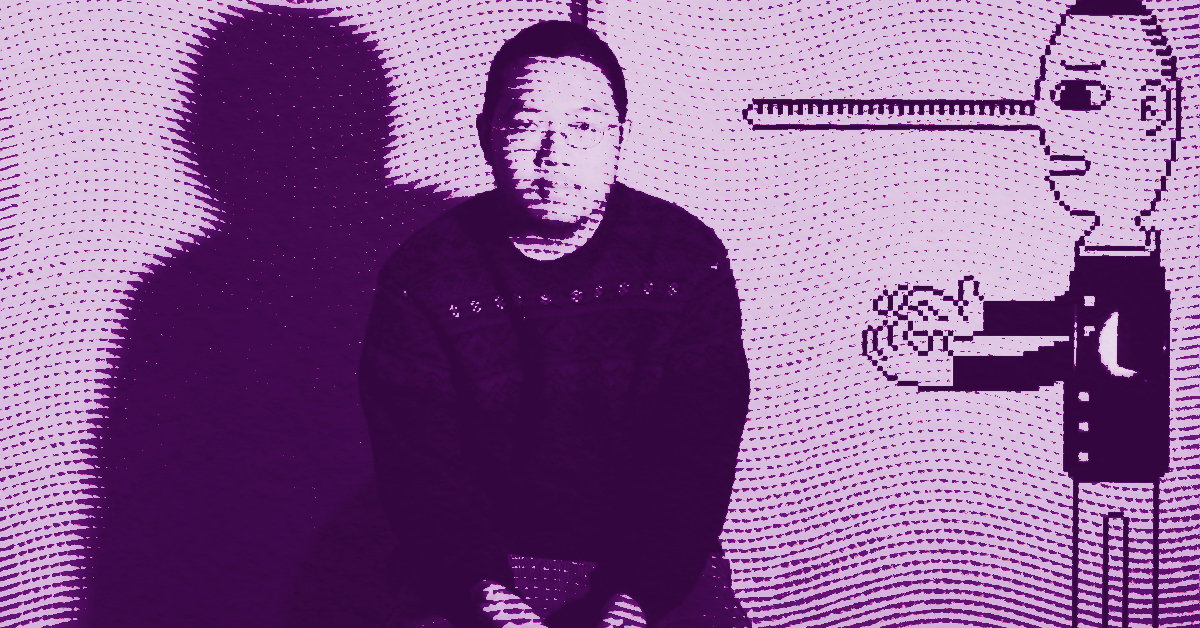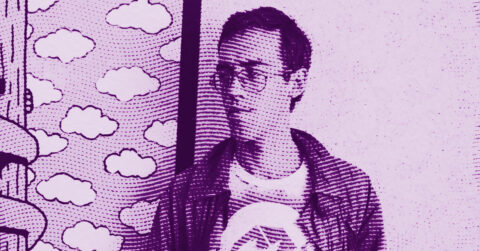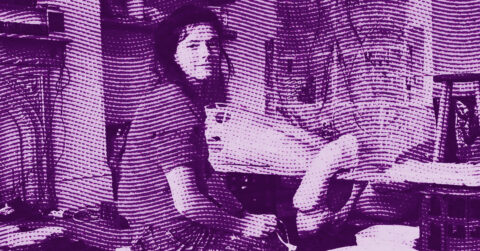Listen to me carefully, you bunch of snobs: while you marvel at the eternal repetitions of the Western contemporary art market, a man draws smoking chimneys on the industrial ruins of China. Yan Cong, born in 1983 in Hubei Province under the name Peng Han, chose as his pseudonym the Chinese word for “chimney,” a choice that is far from accidental for those who want to understand his work. This chimney he constantly evokes, the one that spews its black smoke over the dilapidated suburban landscapes of the Middle Kingdom, becomes under his brush the symbol of a harsh beauty and an aesthetic of decline.
A graduate of the Central Academy of Fine Arts in Beijing where he studied traditional Chinese painting, Yan Cong quickly abandoned conventional paths to turn to comics, a medium still considered children’s literature in China. But here lies the feat: this man does not make comics. He creates graphic narratives that borrow as much from acrylic painting as from collage, as much from outsider art as from German expressionism, and which obstinately refuse to conform to established categories. Represented by Star Gallery in Beijing and Leo Gallery in Hong Kong, he navigates between contemporary art galleries and underground publications, between museum exhibitions and photocopied fanzines sold under the counter.
What immediately strikes in Yan Cong’s universe is this unexpected kinship with German expressionism, a heritage he himself claims by citing the decisive influence of Anke Feuchtenberger on his work. The German artist, born in East Berlin in 1963, has developed since the 1990s an aesthetic drawing from the traditions of woodcut and German expressionist cinema. A professor at the Hamburg University of Applied Sciences since 1997, Feuchtenberger has redefined the potential of comics as an art form through her engagement with various new sources and techniques of graphic narration [1]. Yan Cong confesses: “It is probably under the influence of Anke Feuchtenberger’s work that I draw people with animal heads. In fact, I had never really drawn animals before seeing her works… She really had a huge influence on me!” [2].
This connection between a contemporary Chinese artist and the German avant-garde is not merely a question of stylistic influence. It reveals a deep kinship in the approach to the medium and in the willingness to subvert established conventions. Just as Feuchtenberger and the PGH Glühende Zukunft collective used the aesthetic of expressionist woodcut to differentiate themselves both from East German neo-expressionism and the socialist realism imposed by the state, Yan Cong employs characters with animal heads and desolate industrial settings to create a visual language that escapes the traditional categories of Chinese comics. His hybrid creatures, half-men half-beasts, wander through decomposed urban landscapes where abandoned factories and rusted metal structures create an atmosphere that is neither quite realistic nor outright fantastic.
German Expressionism, with its distorted bodies and claustrophobic spaces, has always been an art of social critique and existential unease. Artists like George Grosz and Otto Dix, whose aesthetic is found in Feuchtenberger’s work, used formal distortion to reveal the underlying tensions of interwar German society. Yan Cong, without falling into servile imitation, appropriates this tradition to document his own reality: that of a rapidly changing China where suburban areas become no man’s lands between modernity and tradition, between development and decay. His settings, often found on the internet rather than directly photographed, acquire through this digital mediation process a particular quality of strangeness. He explains: “I like these dilapidated peri-urban settings. They give me a feeling of strange freshness… When I look at these landscapes, I always hope that something will happen there” [2].
This expectation of something that might occur in these desolate spaces perhaps constitutes the very heart of Yan Cong’s artistic approach. His narratives, far from being conventional linear stories, function as poetic explorations of space and time. His comics, published in China but also in Europe by publishers like Canicola in Italy and Atrabile in Switzerland, resist easy classification. Are they autobiographical? Fictional? The boundary remains deliberately blurred, the artist putting himself on stage in stories that blend lived experiences and imaginary fantasies.
Yan Cong’s relationship to narration reveals a particular conception of comics as an art form. Contrary to the Japanese manga tradition that dominates the Chinese market, or the American superheroes that structure the Western imagination of the medium, his work favors an approach close to graphic poetry. His pages do not seek to tell a story in the traditional sense, but rather to create an atmosphere, to suggest emotional connections between images. This approach echoes what he says about the work of the drawer: “An important part of the drawer’s work is to guide the public through the work.” In his work exhibited at the Shanghai MoCA Pavilion entitled “What to Do When You’re Feeling Dispirited,” he gathers works created during periods of melancholy, transforming the depressive mood into artistic material.
This unconventional narrative dimension is found in his protean practice that refuses to confine itself to a single medium. Yan Cong works in comics, certainly, but also acrylic painting, collage, sewing. In 2014, influenced by the Japanese artist Shinro Ohtake, he embarked on a series of collages made without prior design, simply by collecting and assembling found materials. This collage practice, which produced about 120 pieces in two months, testifies to his constant search for new methods to escape creative inertia. As he explains: “I always seek to explore and enjoy a feeling of loss of control, I try to avoid the inertia that would make me produce old things.”
Yan Cong’s positioning with respect to the art market also reveals the particular tensions that traverse the contemporary Chinese art scene. A member of the collective Special Comix, an anthology of alternative comics printed between 1,000 and 2,000 copies, he operates in an environment where governmental censorship remains ever-present. In 2014, he organized the anthology “Naked Body,” a direct response to the ban on nudity in printed publications in China: an open call for five-page comics where all main characters had to be nude. This gesture of cultural resistance, both subversive and playful, illustrates how independent Chinese artists navigate between political constraints and creative expression.
Yan Cong embodies this generation of Chinese artists who reject the dichotomy between contemporary art and popular culture. His original works are sold in art galleries, but his comics also circulate online, in pirate publications, in photocopied fanzines. He works with commercial galleries while maintaining his editorial independence, even creating his own publication “Narrative Addiction” after withdrawing from the editorial team of Special Comix. This interstitial, uncomfortable but fertile position allows him to question the boundaries between mediums and distribution channels.
In an interview, Yan Cong states he wants to “strengthen the relationship between comics and contemporary art,” and hopes to “subvert the public’s understanding of comics through the combination of comics and easel painting.” He adds: “I just want them to know that comics cannot be absent from the contemporary art community, because I always think that comics are part of contemporary art, even if everyone’s viewing habits haven’t changed” [3].
So here is the project: compel art institutions to recognize comics as a legitimate form of contemporary expression, not by abandoning the medium’s specificities but on the contrary by asserting them. Yan Cong’s hybrid characters, his desolate industrial landscapes, his non-linear narratives are not compromises between comics and contemporary art, but works that fully exist simultaneously in both domains. This dual belonging, far from weakening his work, constitutes its main strength.
Yan Cong reminds us that hierarchies between artistic mediums remain arbitrary social constructions that say more about our cultural biases than about the intrinsic value of works. His smoking chimneys, his animals with human faces, his abandoned factories offer a poetics of decline and transformation that resonates far beyond Chinese borders. In a world where contemporary art often exhausts itself in repeating its own codes, where comics struggle to escape the cultural ghetto that confines them, Yan Cong’s work opens new perspectives. This is not about naively celebrating a supposed fusion of genres, but about recognizing that there are artists capable of working simultaneously in multiple registers without submitting to the dominant logics of any.
The lesson is simple but salutary: art is defined neither by its medium nor by its distribution circuits, but by the artist’s ability to create forms that force us to rethink our categories. Yan Cong, from his Beijing studio, continues to draw his smoking chimneys on the rubble of our aesthetic certainties. And while you are still wondering whether it is comics or contemporary art, he has already moved on to something else.
- Elizabeth Nijdam, “‘Drawing for me means communication’: Anke Feuchtenberger and German Art Comics after 1989”, dissertation, University of Michigan, 2017.
- Interview with Yan Cong by Voitachewski, 2012.
- Sixi Museum, “Yan Cong – Overview”, artist documentation, accessed October 2025.
















